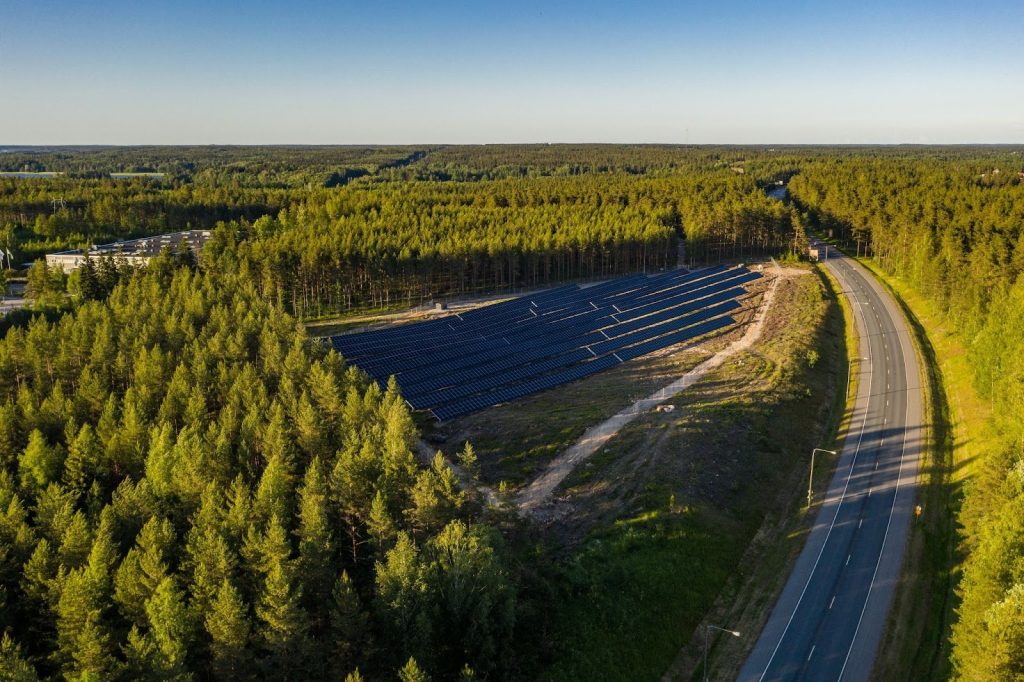Akordi ensures a just clean energy transition by improving stakeholder engagement and collaboration in clean energy projects. Akordi’s FinEst-pilot Clean Energy Transition: Improving Collaboration in Clean Energy Projects focused on key stakeholders and their specific challenges. Read more about the results and download Akordi’s Playbook. The Playbook is now availble in English, Finnish, Swedish and Norwegian.
Elected officials in cities and municipalities make the decisions related to changes in land use and zoning. This means that the local politicians are key players in the implementation of the clean energy transition. Their authority to make these decisions comes from their voters. The council members rely on who prepare the matters to be decided and them implement them.

Local authorities have a large responsibility in the implementation of clean transition infrastructure projects. The municipality’s task is to promote the development of the municipality and the well-being of all residents. In difficult projects and planning decisions, it is important for local acceptability that the municipality can act reliably and impartially among different interests. The municipality is a natural convener when dealing with difficult and controversial issues at the local level.

Developers of green transition projects strive to implement their own projects efficiently and profitably. From a project-focused perspective, corporate social responsibility, local approval, or the so-called social license to operate involve efforts to convince the host community of the company’s good intentions and minimize doubts and resistance to the project. Interdependence means that no single actor can make unilateral decisions and directly implement their wishes without the cooperation and resources of others.

Investors may have short term, or long term financing period and interest rate expectations in mind, but regardless, it is wise for the project developer to invest in strong collaborative relationships with host communities. It pays off in both cases. Investors who want to sell projects soon at a good price know, that responsibly managed projects are easier to sell at the time of exit. On the other hand, investors who fund projects for decades expect that communication and collaboration with the local community is proactive and works well.

Business development companies are regional business coordinators whose job is to reconcile different interests in order to maintain the vitality of municipalities. Land use in clean transition projects quickly raises questions about, for example, meeting municipal climate and biodiversity targets. The discussion then often turns to the quality of life, income generation opportunities, and the availability of services.

New industries bring with them new types of skills requirements. This applies to both teachers and students preparing for working life. Companies have the best knowledge of training needs. They also have the ability to teach company-specific skills alongside work. Therefore, preparing for a smooth transition will mean that educational organizations will need to harmonize their degree programs, make them more modular, and implement them in collaboration with companies through international recruitment.

Ihmiset haluavat vaikuttaa itseään ja elinympäristöään koskeviin asioihin. Siksi hankekehittäjän kannattaa tutustua toimintaympäristöön, rakentaa tilanteeseen sopiva vuorovaikutusprosessi ja ottaa hankkeen vaikutukset haltuun yhdessä paikallisten kanssa.


The increasing tensions in the green transition cause both direct and indirect costs for project developers and stakeholders. Project delays or cancellations waste everyone’s resources. Conflicts deepen divisions and create rifts within local communities and between stakeholders. There is no time to waste. Our collective action problems demand widely accepted solutions.
The test helps you assess the current level of local acceptance of the project. It also provides suggestions on what could still be improved and how.


Take the steps towards project development that builds trust. The project’s timeline shortens if the project is advanced from the start with the needs of different parties in mind – through collaboration.
Decisions are made based on available information. Decision-makers therefore need project developers to provide them with constantly updated information to make judgements related to the benefits and drawbacks of projects.
In the early stages of project development, only a limited number of people, including officials and elected representatives, have access to this information. This is partly due to confidentiality reasons.
After the project proposal has been made public, the need for communication increases dramatically. More detailed information must be continuously disseminated to elected officials beyond the municipal council: to the municipal executive board and committee members. The residents who need information the most are those whose lives will be affected by the project if it is implemented.
Local politics is about forming opinions in interaction between voters and their representatives. If residents can get timely and sufficient answers to the questions that interest them, the easier it will be for their representatives to make decisions on these issues.
Elected representatives usually do their work in their spare time. This means that they do not have unlimited time available for gathering information. The more clearly important issues are presented to them through the channels they prefer to use, the more information will be conveyed. In addition to hundreds of pages of written reports, discussions with experts, video lectures, or visits to example sites may be needed to truly translate information into understanding.
The overall impact of individual zoning decisions is easier to grasp if, at the strategic level, elected representatives and municipal officials have first discussed a common vision for the use of shared resources.
It may be very helpful if, for example, the areas where new industry can be planned and the areas that will not be affected have been defined in advance. These may include areas that can be restored to preserve local biodiversity under construction pressure.
Small municipalities in particular need additional resources to handle green transition infrastructure projects. Resources should be identified as early as possible for increased workload in land use planning, strategy and information production and managing internal and external communication within the municipality. Preferably this happens before individual projects take shape.
Ensuring a desirable future for the local community requires evaluating the impacts of different options. If the conditions and constraints for developing new infrastructure and industrial scale activity can be outlined in a collaborative process together with the communities and stakeholders most affected, it will make the work of the political decision-makers much easier, as they can make their decisions based on shared information and vision.
The project operator’s goal is typically to obtain or secure acceptance for a proposed project or activity. Project planning is often based on the “Decide-Announce-Defend” (DAD) approach, in which the location and technical and economic implementation of the project are planned first, after which the final plans are made public and defended against criticism.
In consent-based approaches, on the other hand, the focus is on the perspective of the host community – the reality and needs of the local community. Consent-based project location enables communities to voluntarily “join in” rather than opposing the project at public meetings.
The community should therefore have the power and opportunity to consider the company’s proposals from its own perspective, to say ‘yes’ or ‘no’ to the offer, and the decision should be based on sufficient understanding of the potential impacts and risks of the project.
Promoting projects is a matter of choice: should we move forward with the project as is, or could project development be built from the ground up based on the needs and consent of the local community? This approach offers companies new opportunities for equitable cooperation with local communities, while allowing for tailored solutions to be found for the location of controversial infrastructure, rather than a “yes or no” scenario.
The reputation of the project developer is one of the investor’s evaluation criteria. When actions are in line with commitments, traces of positive experiences with local communities remain on the internet. By investing in creating and maintaining strong collaborative relationships with host communities throughout the project life cycle, the project developer increases the financing opportunities also for their future projects.
Especially as new technologies become more widespread, regulation may still lag behind. This can lead to developers entering the field who do not understand what they are developing. The indifference of a single project developer, for example, to the impact on nature and the resulting friction at the local level can ruin the reputation of the entire industry.
Investors base their assessment criteria on international responsibility frameworks. However, they also have their own requirements for stakeholder engagement and social impact management. The same is expected of project developers: their own criteria and objectives. Developers should present these to the financiers instead of asking what they should do in relation to their project neighbors in order to obtain financing. Developers are even accountable for the actions of their subcontractors.
A key financing criterion is the profitability of the project. This, in turn, is based on the whole package: capital and operating costs, technology, the location and optimal size of the project, and its life cycle. During this highly complex discussion, people with good negotiation skills and a willingness to constantly come up with new solutions are needed. From this perspective, cooperation with local people to solve common problems is at the heart of the development project.
For farmers, leasing land for a solar park may mean additional income, which can be used to continue farming. The rental income received by municipalities from wind farms can be used to provide services to residents. In this way, even international capital can contribute to the vitality of domestic local communities.
From the perspective of business development companies, the clean transition in Finland is progressing in a project developer-driven manner. It would be easier for regional business coordinators if they had a similar overall picture of the clean transition as the one provided by the regional plan for broader land use planning. Where a regional consensus on the clean transition has been reached, project placement has progressed more quickly than in other parts of the country, even without competition between municipalities.
Where municipalities and their business development companies have succeeded in identifying all the interests that need to be reconciled, it has been possible to engage in proactive planning for certain types of industrial projects. This makes it easier to channel international market interest to suitable investment locations.
Alongside zoning, there is a need to discuss, share information, and educate municipal decision-makers and their voters as well as project development companies. Business development companies are also expected to respond to this need.
First and foremost, business development companies are required to be able to identify and prioritize viable projects. They then need negotiation and networking skills to create an ecosystem of openness and trust. Projects that make it through the screening process expect them to act as “platinum-class A key account managers,” enabling them to quickly progress to industrial-scale business operations, despite the diversity of boundary conditions. In this work, project developers require them to advance to the level of parliament and ministries if necessary.
Business development companies therefore operate in circumstances where there are many interdependent actors and the constraints they impose, and the relationship between the components of a clean transition is not clearly defined at the national, regional, or municipal levels.
Coordination in such circumstances can only take place through dialogue between people who are committed to the cause. This is facilitated, for example, by the strong networking of business development companies with project developers, each other, and Business Finland. This would be further strengthened by stronger networking with civil society.
From the perspective of educational organizations, future skills needs should be envisioned systematically and with a long-term perspective. Students graduate four years after new skills needs are identified. The educational promises made to them regarding employment should be kept. If, on the other hand, there are many more jobs than workers, it becomes difficult for educational institutions to generate income based on degrees: students are recruited by companies even before they graduate.
One solution could be to standardize 80% of engineering education and modularize 20%. The provision of many different modules could be implemented through cooperation between educational institutions to improve their profitability. Corporate cooperation could be utilized, for example, by having company visitors from other parts of Finland give lectures on their own training needs. This could also help students choose their field of study.
Identified skills needs exist, for example, in the battery industry, gas expertise, waste incineration, carbon capture, the circular economy, and the hydrogen economy.
Without extensive international recruitment of both teachers and students, representatives of educational organizations believe that a clean transition will not be possible. If secondary education becomes fee-based for students from outside the EU, they believe that this will have an impact on all manufacturing industries.
The best way to keep skilled workers in Finland is to have them start language studies in their home country, which will help them settle into Finnish local communities and take advantage of Finnish-language education opportunities.
Retention could also be strengthened through inter-company recruitment cooperation. Talented individuals who are known by leading companies as they applied for open jobs but weren’t selected could also be directed to smaller companies in the region.
Ultimately, whether the reforms described above benefit working life depends on the well-being of students. There are major differences between older and younger people in terms of life management skills and expectations of working life. Not all students are able to concentrate and listen anymore. Many have inadequate study skills and well-being. Representatives of educational organizations are concerned about whether they are ready to enter working life.
The need for skilled workers does not therefore mean only top experts and superstars, but dedicated, positive-minded individuals with initiative. Ensuring this begins by making sure that the leaders of tomorrow are not marginalized during their studies.